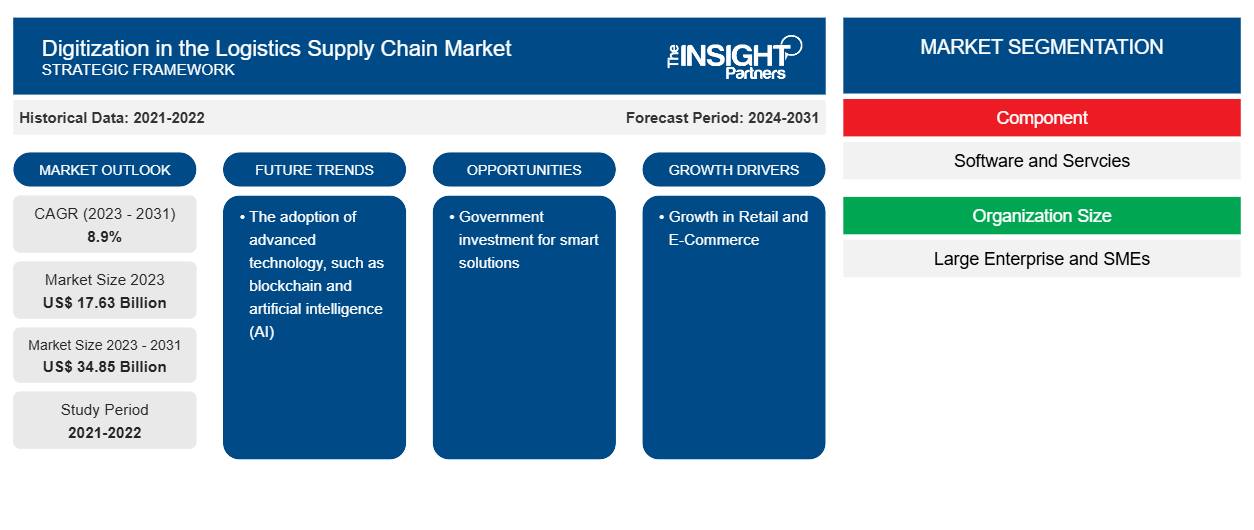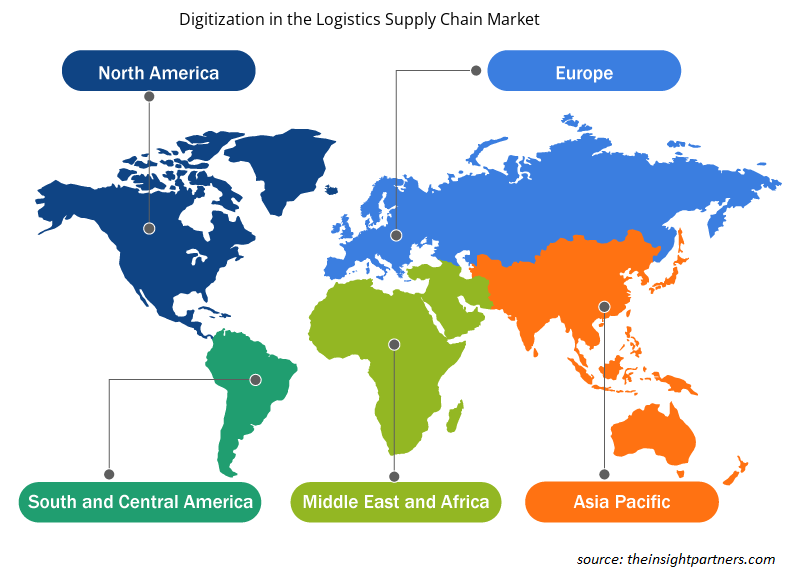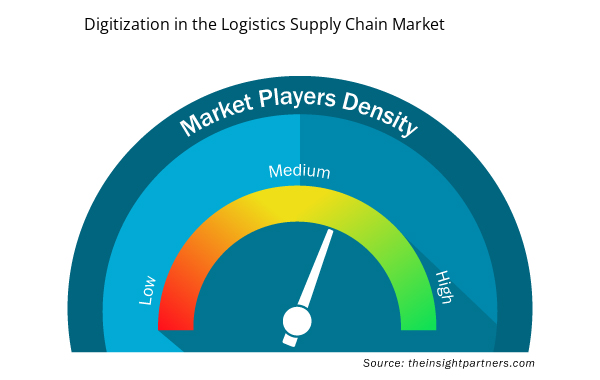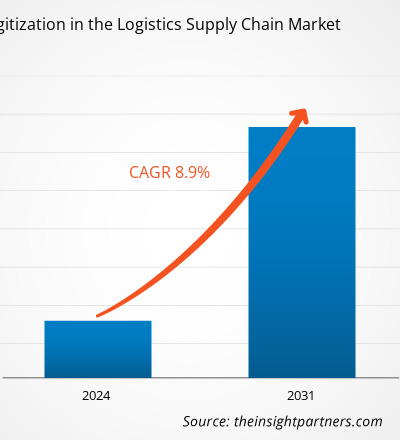The digitization in the logistics supply chain market size is projected to reach US$ 34.85 billion by 2031 from US$ 17.63 billion in 2023. The market is expected to register a CAGR of 8.9% in 2023–2031. Increasing demand for supply chain management and increasing retail and e-commerce industry are likely to remain key digitization in the logistics supply chain market trends.
Digitization in the Logistics Supply Chain Market Analysis
Automation across various industries such as automotive, retail and e-commerce, manufacturing, healthcare, and others has benefitted the operators of these industries on a large scale by reducing human errors. For example, the retail worldwide is continuously growing and is expected to grow more in the future. Thus, the growing retail industry is focusing on lowering total operational costs by removing manual operations for stocking and managing the supply chain and logistics. The demand for automation solutions throughout the retail industry fuels the market. The logistics sector across several industries is witnessing digital transformation as stakeholders are inclined towards minimizing errors, enhanced operations, and on-time delivery, which is propelling the market.
Digitization in the Logistics Supply Chain Market Overview
Progressing digital transformation is changing traditional business models to be more effective and efficient. The adoption of digital technologies helps market players across several industries to gain a competitive advantage over the other players by optimizing their business models. Digitalizing the logistics supply chain operations helps them to save costs on the workforce, fasten their processes, and minimize errors. The inclusion of more advanced technologies, such as artificial intelligence (AI) helps them to make effective business decisions with advanced analytics.
Customize This Report To Suit Your Requirement
You will get customization on any report - free of charge - including parts of this report, or country-level analysis, Excel Data pack, as well as avail great offers and discounts for start-ups & universities
Digitization in the Logistics Supply Chain Market: Strategic Insights

- Get Top Key Market Trends of this report.This FREE sample will include data analysis, ranging from market trends to estimates and forecasts.
You will get customization on any report - free of charge - including parts of this report, or country-level analysis, Excel Data pack, as well as avail great offers and discounts for start-ups & universities
Digitization in the Logistics Supply Chain Market: Strategic Insights

- Get Top Key Market Trends of this report.This FREE sample will include data analysis, ranging from market trends to estimates and forecasts.
Digitization in the Logistics Supply Chain Market Drivers and Opportunities
Growth in Retail and E-Commerce to Favor Market
The rise in income and purchasing power of individuals has been a major factor leading to the growth in the retail and e-commerce industry. The rise in mobile penetration and internet connections has provided feasibility and easy accessibility to the retail industry, leading to the growing e-commerce industry. According to the India Brand Equity Foundation (IBEF), countries such as the US, Canada, Germany, United Kingdom, China, Japan, France, Australia, Switzerland, Italy, and India are among others with a robust retail market. Digitization in the logistics supply chain helps the stakeholders in the supply chain to optimize their operations. Digitalization helps in the real-time tracking and tracing of orders and raw materials in the supply chain. It helps to efficient coordination between the manufacturers, suppliers, distributors, and retailers to reduce costs, increase quality, and meet customer demands. Thus, the growth in retail and e-commerce drives the demand for solutions to enhance the supply chain and logistics workflow which further drives the digitization in the logistics supply chain market growth.
Government investment for smart solutions – An Opportunity in Digitization in the Logistics Supply Chain Market
To promote digitalization worldwide, the government is investing in smart solutions. Bringing smart solutions helps boost production, optimize operations, and provide a higher return on investment. It helps to simplify complex business models and foster faster operations.
- In September 2023, the Biden-Harris Administration announced US$ 160 Million for smart transportation technology. This investment also focused on systems innovation, such as delivery and logistics, traffic signals, smart grid, and data integration.
- In February 2023, the Indian Finance Minister announced a budget allocation of approximately US$ 3363.5 million (INR 27,482 crore) for the Dedicated Freight Corridor Corporation of India (DFCC), a 75% rise compared to the previous year. The budget speech highlighted the prioritization of 100 crucial transport infrastructure projects, such as last and first-mile delivery for ports, coal, steel, fertilizers, and food grains.
Thus, such investments can boost digitalization in the logistics and supply chain sector and act as an opportunity for market growth.
Digitization in the Logistics Supply Chain Market Report Segmentation Analysis
Key segments that contributed to the derivation of digitization in the logistics supply chain market analysis are components, organization size, and industry.
- Based on components, the market is bifurcated into software and services. The software segment held a larger market share in 2023.
- By organization size, the market is segmented into large enterprises and SMEs. The large enterprise segment held the largest share of the market in 2023.
- By industry, the market is segmented into retail and e-commerce, healthcare, manufacturing, automotive, and others. The retail and e-commerce segment held the largest share of the market in 2023.
Digitization in the Logistics Supply Chain Market Share Analysis by Geography
The geographic scope of digitization in the logistics supply chain market report is mainly divided into five regions: North America, Asia Pacific, Europe, Middle East & Africa, and South America/South & Central America.
In terms of revenue, North America accounted for the largest digitization in the logistics supply chain market share. The US, Canada, and Mexico are among the key countries in North America. The region is an early adopter of technologically advanced solutions, which is one of the key factors driving the market growth. The rise in the retail and e-commerce industry in the region generates the demand for digital solutions to optimize supply chain and logistics activities, which foster the market. According to the US Department of Commerce, US retail and food services sales rose by 0.6% in February 2024 compared to January 2024. In addition, according to International Trade Administration, Canada had around 75% of e-commerce users of Canada’s total population in 2022 which is expected to rise to 77.6% by 2025. People in Canada buying stuff online is increasing, contributing to the country's increased e-commerce activities such as product delivery operations.
Digitization in the Logistics Supply Chain Market Regional Insights
The regional trends and factors influencing the Digitization in the Logistics Supply Chain Market throughout the forecast period have been thoroughly explained by the analysts at Insight Partners. This section also discusses Digitization in the Logistics Supply Chain Market segments and geography across North America, Europe, Asia Pacific, Middle East and Africa, and South and Central America.

- Get the Regional Specific Data for Digitization in the Logistics Supply Chain Market
Digitization in the Logistics Supply Chain Market Report Scope
| Report Attribute | Details |
|---|---|
| Market size in 2023 | US$ 17.63 Billion |
| Market Size by 2031 | US$ 34.85 Billion |
| Global CAGR (2023 - 2031) | 8.9% |
| Historical Data | 2021-2022 |
| Forecast period | 2024-2031 |
| Segments Covered |
By Component
|
| Regions and Countries Covered | North America
|
| Market leaders and key company profiles |
Digitization in the Logistics Supply Chain Market Players Density: Understanding Its Impact on Business Dynamics
The Digitization in the Logistics Supply Chain Market is growing rapidly, driven by increasing end-user demand due to factors such as evolving consumer preferences, technological advancements, and greater awareness of the product's benefits. As demand rises, businesses are expanding their offerings, innovating to meet consumer needs, and capitalizing on emerging trends, which further fuels market growth.
Market players density refers to the distribution of firms or companies operating within a particular market or industry. It indicates how many competitors (market players) are present in a given market space relative to its size or total market value.
Major Companies operating in the Digitization in the Logistics Supply Chain Market are:
- SAP SE
- Oracle Corporation
- IBM
- Intel Corporation
- Infor
- Hexaware Technologies Limited
Disclaimer: The companies listed above are not ranked in any particular order.

- Get the Digitization in the Logistics Supply Chain Market top key players overview
Digitization in the Logistics Supply Chain Market News and Recent Developments
Digitization in the logistics supply chain market is evaluated by gathering qualitative and quantitative data post primary and secondary research, which includes important corporate publications, association data, and databases. The following is a list of developments in the market:
- In December 2023, Fujitsu announced the launch of a new cloud-based logistics data standardization and visualization service for shippers, logistics companies, and vendors across the supply chain. The service offers new tools to customers to achieve sustainability in their operations and address a variety of challenges, including looming shortages of truck drivers, the urgent need to reduce the carbon footprint of transportation, and compliance with stricter industry regulations. (Source: Fujitsu, Press Release, 2023)
- In January 2024, Blue Yonder, a leading supply chain solutions provider, announced the release of its largest product update in the history of the company, launched the first set of interoperable solutions across the entire supply chain – from planning to warehouse, transportation, and commerce – delivered on the company’s Luminate Cognitive Platform. Leaning into interoperability allows Blue Yonder to provide its customers with increased productivity, reduced waste, and more resilient supply chains. (Source: Blue Yonder, Press Release, 2024)
Digitization in the Logistics Supply Chain Market Report Coverage and Deliverables
The “Digitization in the Logistics Supply Chain Market Size and Forecast (2021–2031)” report provides a detailed analysis of the market covering below areas:
- Market size and forecast at global, regional, and country levels for all the key market segments covered under the scope
- Market dynamics such as drivers, restraints, and key opportunities
- Key future trends
- Detailed PEST/Porter’s Five Forces and SWOT analysis
- Global and regional market analysis covering key market trends, major players, regulations, and recent market developments
- Industry landscape and competition analysis covering market concentration, heat map analysis, prominent players, and recent developments
- Detailed company profiles
- Historical Analysis (2 Years), Base Year, Forecast (7 Years) with CAGR
- PEST and SWOT Analysis
- Market Size Value / Volume - Global, Regional, Country
- Industry and Competitive Landscape
- Excel Dataset



Report Coverage
Revenue forecast, Company Analysis, Industry landscape, Growth factors, and Trends

Segment Covered
Component ; Organization Size ; Industries

Regional Scope
North America, Europe, Asia Pacific, Middle East & Africa, South & Central America

Country Scope
Argentina, Australia, Brazil, Canada, China, France, Germany, India, Italy, Japan, Mexico, Russian Federation, Saudi Arabia, South Africa, South Korea, United Arab Emirates, United Kingdom, United States
Frequently Asked Questions
What is the estimated market size for the global digitization in the logistics supply chain market in 2023?
The global digitization in the logistics supply chain market was estimated to be US$ 17.63 billion in 2023 and is expected to grow at a CAGR of 8.9% during the forecast period 2023 - 2031.
What are the driving factors impacting the global digitization in the logistics supply chain market?
Increasing demand for digital solutions across various industries and growth in the retail and e-commerce industry are the major factors that propel global digitization in the logistics supply chain market.
What are the future trends of global digitization in the logistics supply chain market?
The adoption of advanced technology, such as blockchain and artificial intelligence (AI), is anticipated to play a significant role in the global digitization of the logistics supply chain market in the coming years.
What will be the market size of the global digitization in the logistics supply chain market by 2031?
The global digitization in the logistics supply chain market is expected to reach US$ 34.85 billion by 2031.
Which are the key players holding the major market share of the global digitization in the logistics supply chain market?
The key players holding majority shares in the global digitization in the logistics supply chain market are SAP SE, Oracle Corporation, Infor, IBM, and Intel Corporation.

 Get Free Sample For
Get Free Sample For